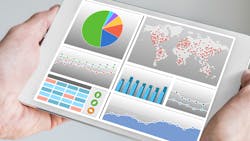I’ve got a pet peeve about the terms metrics and KPIs (key performance indicators). Too many people use those terms interchangeably, and while it may seem like a small thing, it drives me a little crazy because they are not the same. However, they do have a relationship with each other.
Let’s start with some definitions:
- A metric is a system or standard of measurement. Metrics measure daily activity.
- KPIs are goals or targets you set for yourself around the metrics so you can measure your performance improvement.
Here are some examples of the difference. You can measure how many preventive maintenance services you perform in a day, week, or month. That is a metric. And you can set a KPI of 12 PMs a day based on the fact that you currently are completing 10 PM services a day.
Or you can look at your ability to stay current on PMs. If you are at 95% PM currency—the metric—you can set a goal of 98%—the KPI. If you know your on-time delivery is 95%—the metric—you can set a goal of 98%—the KPI.
See also: The importance of KPIs for performance gains
Both metrics and KPIs are important in your business, but you need to understand the difference between them. You can’t set KPIs without first having metrics in place. Each fleet will have different metrics—different things they want to measure. Typically, we set metrics around areas that need improvement, and each fleet has things it does well and other areas where performance is lacking.
The first step to improving is to take a close look at your operation and gather data on your performance. Based on that data, determine the areas in which you need to do better. Those are the metrics you need to look at, and the current data defines how well you are doing. Then set KPIs (i.e., a target or goal, your ideal or vision for improved performance) for each metric based on your current performance numbers. Of course, you will have to put things in place to improve performance and once those are implemented you can then track your metric to see how close you are to achieving your goals—a.k.a. meeting your KPIs.
Metrics and KPIs, while connected, are not the same. Learning the difference and implementing them both properly should lead to big improvements. And will relieve me of my pet peeve.
Gino Fontana, CTP, is COO and EVP at Transervice Logistics Inc. Prior to this, he was VP of operations at Berkeley Division and Puerto Rico. He has more than 35 years of experience in the transportation and logistics industry with both operational and sales experience.
About the Author
Gino Fontana
Chief operating officer and executive vice president at Transervice Logistics Inc.
Gino Fontana, CTP, is COO and EVP at Transervice Logistics Inc. His operational expertise emphasizes cost savings, process efficiency and improvement, superior quality, and people management skills. He has more than 35 years of experience in the transportation and logistics industry with both operational and sales experience.
